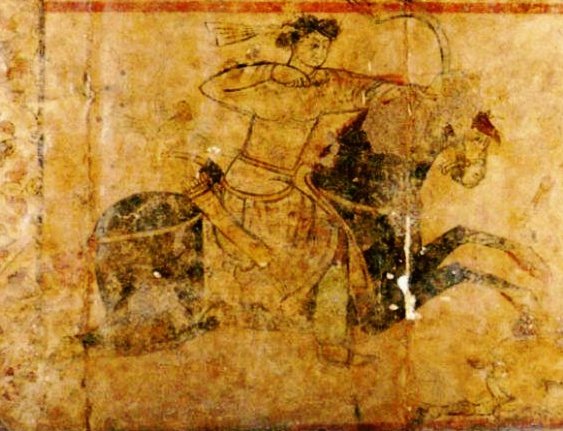Create an Amazon Business Account

Register a SNAP EBT card with Amazon
Detail from a
floor painting with hunting scene
Umayyad, Qasr al-Hayr al-Gharbi, 727AD

A larger image of the horse-archer in a floor painting. Umayyad, Qasr al-Hayr al-Gharbi, Syria.
A reconstruction of the Qasr al-Hayr al-Gharbi floor - Plate B Deux fresques omeyyades, Syria 25, 1946-48 by D. Schlumberger
Original Owner: Caliph Hisham bin 'Abd al-Malik (r. AH 10525 / AD 72443)
Dimensions: Length 5 m, width 4.85 m
Material(s) / Technique(s): Plaster, painted using the secco technique.
Date of the object: Hegira 109 / AD 727
Period / Dynasty: Umayyad
Provenance: Syrian Desert; 80 km southwest of Palmyra.
Description:
The Umayyad desert palaces show clearly the influence of earlier artistic traditions both from the Byzantine Empire in the West, and the Sassanid Empire in the East, what is now modern Iran.
This painting shows the influence of the art and mythology of the Sassanids.
It covered the floor of the reception room in the east wing of Qasr al-Hayr al-Gharbi.
The lower section portrays a clean-shaven hunter galloping on horseback.
The hunter is dressed in Sassanid-style fashion; his head-scarf flying behind him, his bow and arrow are drawn tight for the catch.
On the lower right-hand corner is a gazelle, running away while looking back.
Held by National Museum of Damascus, Syria. Inv. no. QHG. Reference: Museum with No Frontiers. Picture Source
Referenced as figure 120 in The military technology of classical Islam by D Nicolle
120. Fresco from Qaṣr al Ḥayr al Gharbī, mid-8th century AD, Syrian, National Museum, Damascus
Referenced on p.44, EH - 071 - The Great Islamic Conquests AD 632-750 by David Nicolle
This well preserved wall-painting from the Umayyad fortified complex now known as Qasr al-Hayr al-Gharbi on the western edge of the Syrian desert
has many features in common with the damaged stucco relief carving of a horse-archer from the same site.
In the painting, however the man rides with stirrups which were only now being introduced to the Middle East from Central Asia.
He also wears a Turkish Central Asian style belt with decorative pendants while a bowcase containing a second unstrung bow is visible on his left hip.
(National Museum, Damascus, Syria)
Referenced on p.7, The Armies of Islam 7th-11th Centuries by David Nicolle & Angus McBride
Fresco from Qasr al Hayr, showing a horse-archer of Transoxanian type.
The original shows some detail of heavy stirrups, quiver, an unstrung bow in a decorative case, and Turkish-style decorative pendants from his belt.
Our detail here shows the characteristic thumb-draw used to pull a Central Asian composite bow. (National Museum, Damascus)
A Khorasanian Horse Archer from Armies of the Dark Ages 600-1066 by Ian Heath, based on the Qasr al-Hayr al-Gharbi floor painting.
Fragments of an Umayyad Statue of a Standing Prince, Qasr al-Hayr West.
See also Umayyad Soldiers on a Coin of Yazīd ibn al Muhallab, early 8th century AD, Gurgān: Coll. of the American Numismatic Society.
A Sasanian (or Umayyad?) Horseman on a Stucco Panel, 7th century, Metropolitan Museum of Art, New York
Umayyad Frescoes from Quṣayr ʿAmra, mid-8th century AD, Syrian, in situ, Jordan
Plates with figures from Persia and Central Asia (and bowls, cups, cameos, plaques, paintings and textiles with similar iconography)

